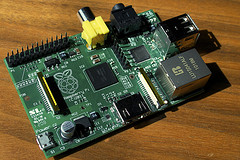
Much has been said about the Raspberry Pi and its usefulness as a tool for learning. The long waiting lists and competitive price of the Pi have created widespread euphoria. However, as all the excitement dies down, and people begin to receive their Pi, many critics have appeared asking how useful is the Pi?
Many critics and blog posts are comparing it to the iPad, which is futile as they are polar opposites. The Pi was developed as a tool to invoke learning, not as a wow piece of technology. The Pi is for content creation as opposed to content consumption. It is not the physical Pi that is the exciting technology - you don’t purchase it because of its processor speed, graphics ability or even its size - its fundamental strength is as a vehicle to develop students' computing competence and understanding.
Photo credit: Roo Reynolds

















